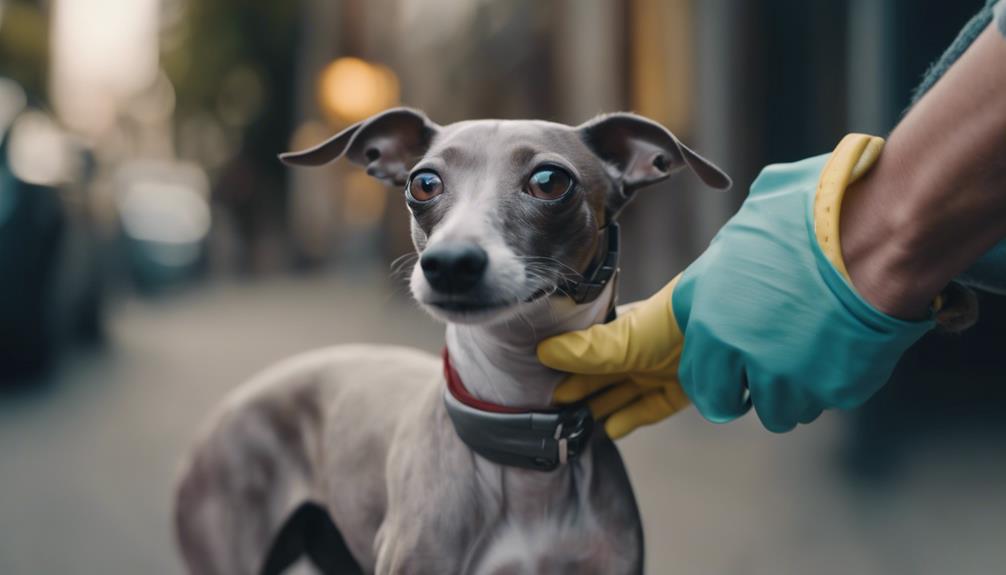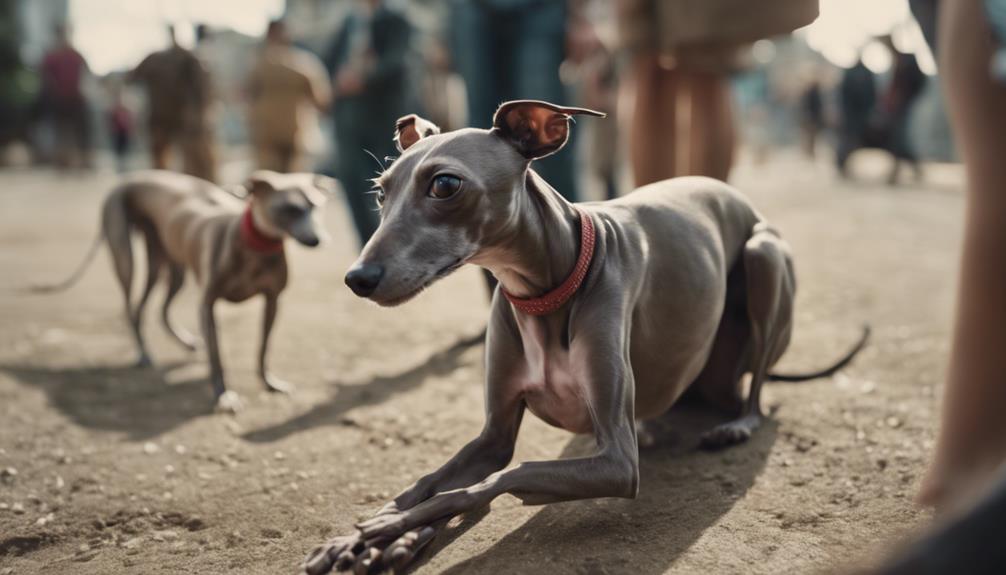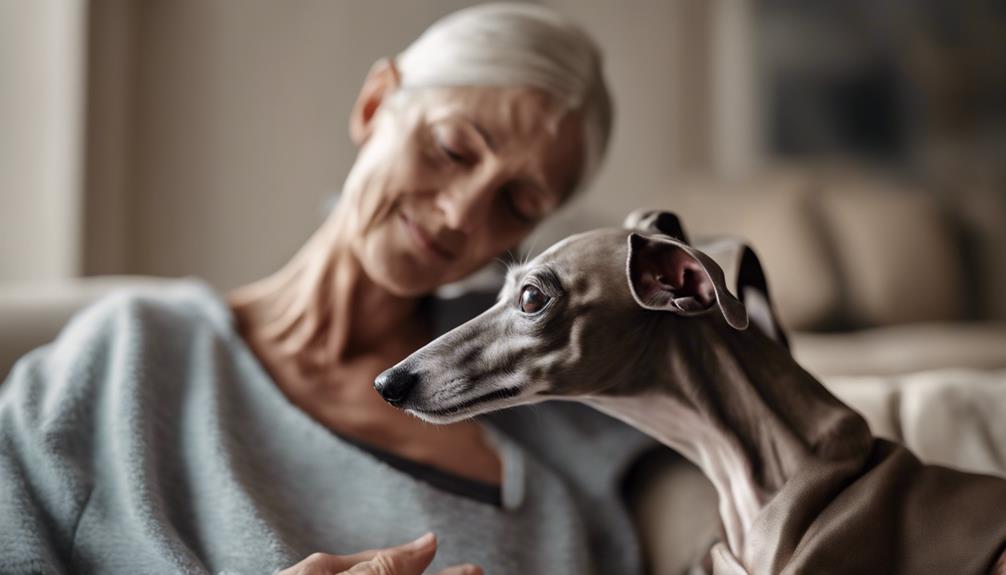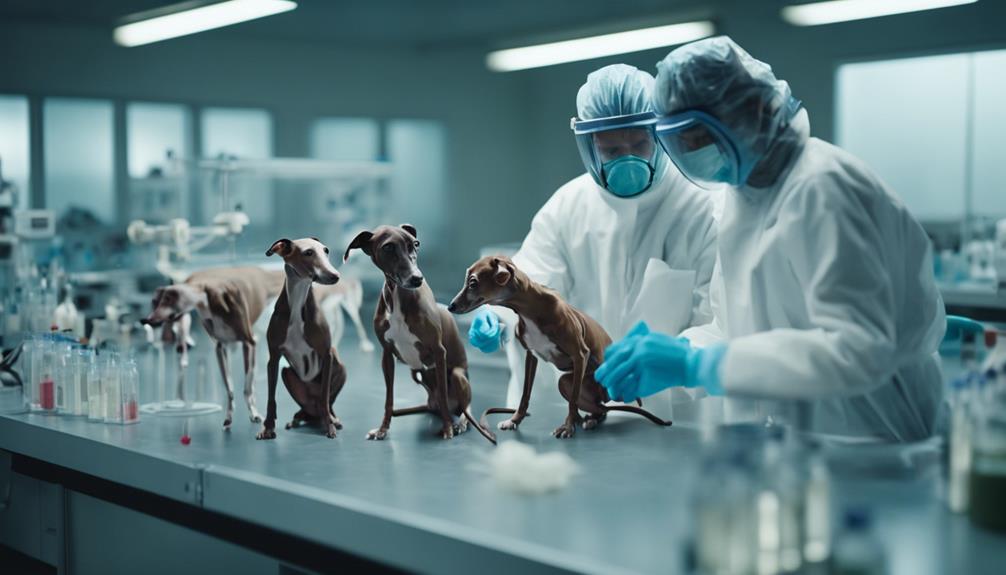The intricate dynamics of zoonotic diseases have once again come under scrutiny with the recent revelation of human-to-pet transmission of monkeypox, exemplified by the case of an Italian greyhound contracting the virus from its owners. This discovery not only raises alarms but also prompts a reevaluation of our interactions with companion animals in a shared environment.
As we navigate through the implications of this study, a deeper exploration of the potential ramifications for both human and canine health unveils a complex web of interconnectedness that necessitates urgent attention and proactive measures.
Key Takeaways
- Monkeypox can be transmitted from humans to dogs, as seen in an Italian greyhound.
- Close contact, lesions, and ulcers are signs of monkeypox in infected dogs.
- DNA sequencing confirmed the virus strain similarity between the dog and a human.
- Isolating infected individuals from pets is crucial to prevent zoonotic disease transmission.
Monkeypox Transmission and Symptoms
Understanding the transmission routes and clinical manifestations of monkeypox is crucial in managing the spread of this zoonotic disease between humans and animals.
Monkeypox primarily spreads through close physical contact among humans, including sexual contact. While respiratory issues can arise, fatalities are rare, with available vaccines for prevention.
A notable case involved an Italian greyhound showing symptoms 12 days after the humans displayed signs, presenting lesions, pustules, and ulcerations. DNA sequencing confirmed the dog and one human shared the same virus strain, highlighting the potential for interspecies transmission.
This emphasizes the importance of early detection, isolation, and proper preventive measures to curb the spread of monkeypox.
Human-to-Pet Transmission of Monkeypox
In light of recent findings by French scientists, evidence suggests a concerning trend of human-to-pet transmission of monkeypox, exemplified by a case involving a 4-year-old Italian greyhound in Paris contracting the virus from its human cohabitants. This discovery raises important considerations regarding the potential for zoonotic disease transmission between humans and their animal companions.
Key Points:
- Research Impact: French scientists' study in The Lancet highlights the ability of humans to infect their pets with monkeypox.
- Public Health Implications: Understanding and addressing human-to-pet transmission is crucial for controlling zoonotic diseases like monkeypox.
- Preventive Measures: Recommendations include isolating individuals with monkeypox from their pets to prevent further transmission.
Recommendations and Guidelines for People

The CDC provides essential recommendations and guidelines for individuals diagnosed with monkeypox to prevent further transmission of the disease to their pets. Infected individuals are advised to avoid contact with animals, including pets, and should refrain from activities such as petting, cuddling, hugging, kissing, and sharing food with them.
Similar precautions to those for pet owners with COVID-19 are recommended. People can safely reunite with their pets post-recovery from monkeypox. It is important to consult a veterinarian if any questions arise about pet care during the infection period.
Pet Health Concerns and Related Articles
Following the CDC's guidelines for individuals diagnosed with monkeypox, it is crucial for pet owners to stay informed about potential health risks to their pets from various diseases, including rabies, parvo, and COVID-19.
Pet Health Concerns and Related Articles:
- Rabies in Cats: Learn about the symptoms and preventive measures for rabies in felines.
- Parvo in Dogs: Understand the dangers of parvovirus in dogs and how to protect your furry friend.
- COVID-19 in Pets: Stay updated on the latest information regarding the impact of COVID-19 on dogs and cats.
It's essential for pet owners to educate themselves on these issues, consult veterinarians regularly, and take preventive measures to ensure their pets' well-being.
Importance of Preventing Zoonotic Disease Transmission

Understanding the critical role of preventing zoonotic disease transmission is paramount for safeguarding both human and animal health.
Zoonotic diseases, such as monkeypox, pose significant risks due to their ability to transfer between humans and animals. By recognizing and understanding the transmission routes of these diseases, effective preventive measures can be implemented to curb their spread.
Isolating infected individuals from pets is a key strategy in reducing the risks of zoonotic disease transmission. Heightened awareness and strict adherence to guidelines not only protect human health but also contribute to the well-being of animals.
Collaborative efforts between health authorities, veterinary professionals, and pet owners are essential for effective disease control and prevention in both human and animal populations.
DNA Sequencing Confirms Virus Strain Match
Recognizing the significance of matching virus strains through DNA sequencing is pivotal in understanding and controlling zoonotic disease transmission, as exemplified by the confirmed correlation between the Italian greyhound and a human infected with monkeypox.
DNA sequencing plays a crucial role in confirming the source and transmission pathways of zoonotic diseases.
Identifying matching virus strains between humans and animals aids in tracking and controlling disease outbreaks.
The confirmation of a shared virus strain between the Italian greyhound and an infected human highlights the direct link between cross-species transmission. This finding underscores the importance of genetic analysis in investigating and managing zoonotic infections effectively.
French Scientists Confirm Human-to-Pet Transmission

French scientists have provided confirmation of human-to-pet transmission of monkeypox, emphasizing the potential risks posed by zoonotic diseases in households. A 4-year-old Italian greyhound in Paris contracted the virus from the humans he lives with, as outlined in research published in The Lancet.
The study suggests that humans can indeed transmit monkeypox to their pets, highlighting the importance of preventive measures. Authors recommend isolating individuals infected with monkeypox from their pets to curb transmission.
This recent finding underscores the need for increased awareness and adherence to guidelines to safeguard both human and animal health. Collaborative efforts between health authorities and pet owners are crucial in controlling the spread of zoonotic diseases like monkeypox.
CDC's Recommendations for Infected Individuals
The Centers for Disease Control and Prevention (CDC) provides crucial recommendations for individuals infected with monkeypox to prevent further transmission to their pets.
- Isolation: Infected individuals should isolate themselves from their pets to avoid transmitting the virus.
- Avoid Close Contact: The CDC advises against petting, cuddling, hugging, kissing, or sharing food with pets while infected.
- Consultation: It is recommended to consult a veterinarian if there are any questions regarding pet care during the infection period.
Precautions for Pet Owners With COVID-19

During the ongoing COVID-19 pandemic, pet owners are urged to take specific precautions to safeguard both their own health and the well-being of their animals. The Centers for Disease Control and Prevention (CDC) recommend that individuals infected with COVID-19 avoid close contact with their pets to prevent potential transmission of the virus. This includes refraining from petting, cuddling, kissing, or sharing food with pets.
If possible, have another household member care for the pet while you are sick. In cases where this is not feasible, wear a face mask and wash hands thoroughly before and after interacting with your pet. Following these guidelines can help protect both pet owners and their beloved animals during these challenging times.
Reuniting With Pets Post-Recovery
After recovering from monkeypox, individuals should proceed cautiously when reuniting with their pets. This cautious approach is crucial to prevent any potential transmission of the virus back to the animals. Here are three key steps to consider when reuniting with pets post-recovery:
- Consult a Veterinarian: Seek professional advice to ensure the safety of both the pet and the individual post-recovery. Veterinarians can provide guidance on how to safely reintroduce contact with the pet.
- Monitor Pet's Health: Keep a close eye on the pet's health post-reunion. Look out for any unusual symptoms or behaviors that may indicate illness.
- Follow CDC Guidelines: Adhere to recommended guidelines from health authorities, such as the CDC, on interacting with pets post-recovery to minimize the risk of retransmission.
Collaborative Efforts for Disease Control

Effective disease control necessitates a coordinated effort between health authorities and pet owners to mitigate zoonotic risks and safeguard public health. Collaborative initiatives such as joint awareness campaigns, surveillance programs, and rapid response strategies are essential for controlling the spread of zoonotic diseases like monkeypox.
| Collaborative Efforts for Disease Control | Benefits |
|---|---|
| Joint Awareness Campaigns | Enhance public education on zoonotic risks and prevention measures. |
| Surveillance Programs | Early detection of outbreaks and monitoring of disease transmission dynamics. |
| Rapid Response Strategies | Prompt containment measures to prevent further spread of zoonotic diseases. |
Conclusion
In conclusion, the study highlighting human-to-pet transmission of monkeypox underscores the importance of preventive measures and collaboration in safeguarding both human and animal health. Understanding and adhering to recommendations and guidelines can help mitigate the risks of zoonotic disease transmission.
Pet owners play a crucial role in this effort, and concerted efforts between health authorities and individuals responsible for pet care are essential in preventing the spread of such diseases.




